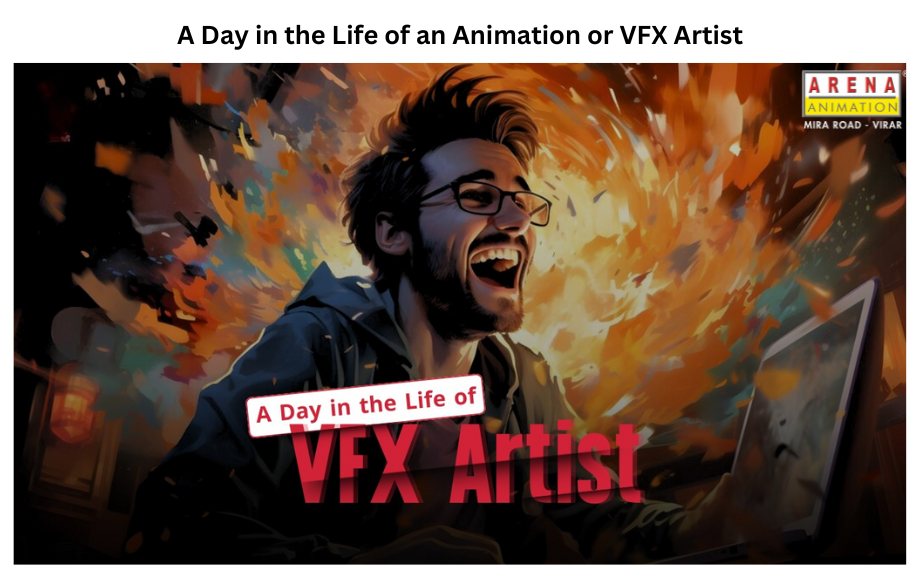Explore a day in the life of an Animation or VFX artist – from creativity to deadlines!

Ever wondered what it’s like to be an animation or VFX artist? Whether you love animated movies, dream of working on big action films, or just want to explore a creative career, this blog will give you a sneak peek into a typical day in the life of an artist in this field.
From morning meetings to late-night rendering, animation and VFX artists have an exciting yet challenging job. Let’s dive into their daily routine, the software they use, and the career path they follow.
Morning: Planning and Team Meetings
The day usually starts with a team meeting. Whether working in a studio or as a freelancer, an artist needs to know their tasks for the day. Teams discuss deadlines, review work, and plan the next steps. If you’re working on a film, gaming project, or advertisement, your work depends on the direction given by the project manager or supervisor.
After the meeting, artists check their emails and messages for any updates or feedback from clients. Good communication is crucial in this field because projects involve multiple people, including designers, editors, and programmers.
Mid-Morning: Creating Animations and Effects
Once the planning is done, it’s time to start working on animations, motion graphics, or special effects. This is where the magic happens! Depending on the project, the artist might be:
- Designing characters and backgrounds in graphic designing classes
- Creating 3D models in software like Autodesk Maya or Blender
- Adding visual effects to a scene in Adobe After Effects or Nuke
- Working on motion graphics in motion classes
At this stage, attention to detail is super important. Even a small mistake can affect the entire scene. Artists constantly check their work and make adjustments to ensure it looks perfect.
Lunch Break: Refreshing the Mind
After hours of sitting in front of a screen, a lunch break is necessary. Many artists take this time to relax, chat with colleagues, or even watch some animation clips for inspiration. Keeping the mind fresh is essential for creativity.
Afternoon: Feedback and Editing
Once the first version of the animation or VFX is ready, artists send it to their seniors or clients for review. Feedback is an important part of the process because there are always changes to be made. Whether it’s adjusting the colors, improving the movement, or fixing errors, edits can take a lot of time.
This is also when video editing comes into play. Many artists work alongside editors who fine-tune the final video. If you’re interested in this, you can take a video editing course in Mira Road or video editing course in Virar to improve your skills.
Evening: Final Touches and Rendering
As the day comes to an end, artists add the finishing touches. Rendering is the final step, where all animations, effects, and textures are processed into a final video file. This process can take several hours, depending on the complexity of the project.
Many artists use this time to learn new skills. If you’re a beginner, joining a VFX class in Mira Road or VFX class in Virar can help you understand industry techniques and software. You can also explore a motion course in Mira Road or motion course in Virar to expand your knowledge.
Q&A: Common Questions About the Life of an Animation or VFX Artist
1. Is the job of an animation or VFX artist difficult?
Yes, it can be challenging, but if you love creativity, it’s also exciting. The work requires patience, attention to detail, and practice.
2. What software do VFX artists use daily?
Some of the most used software include:
- Autodesk Maya (for 3D animation)
- Blender (for 3D modeling and animation)
- Adobe After Effects (for motion graphics and VFX)
- Nuke (for compositing)
3. What is the career path in VFX and animation?
You can start by taking an animation course in Virar or an animation course in Mira Road. Then, you can apply for jobs as:
- Junior Animator or VFX Artist
- Mid-Level Artist
- Senior Animator or VFX Supervisor
- Art Director or Technical Director
4. How can I start my career in animation or VFX?
Begin by joining animation classes, VFX classes, or graphic designing classes. If you live in Virar or Mira Road, you can find the best institute for graphic design in Virar or Mira Road to learn industry skills.
Useful Links for Learning Animation and VFX
If you want to start your journey, check out these resources:
- Autodesk Maya – Beginner’s Guide
- Blender Official Tutorials
- Adobe After Effects Training
- Nuke Compositing Software
Final Thoughts
A career in animation or VFX is full of creativity, challenges, and growth. If you have a passion for animation, you can make a successful career by learning the right tools and techniques. Start by joining animation classes, VFX classes, or graphic designing classes to build your skills. If you’re in Virar or Mira Road, explore the best institute for graphic design in Virar or Mira Road to get started.
Want to see more industry updates and tips? Follow us on our social media platforms!
Our Social Media Links:
📷 Instagram: Arena Animation Mira Road & Virar
📘 Facebook: Arena Animation Mira Road & Virar
🐦 Twitter: Arena Animation Virar
▶️ YouTube: Arena Animation Virar
💼 LinkedIn: Arena Animation Mira Road & Virar
📖 Read our more blogs: Arena Animation Blog